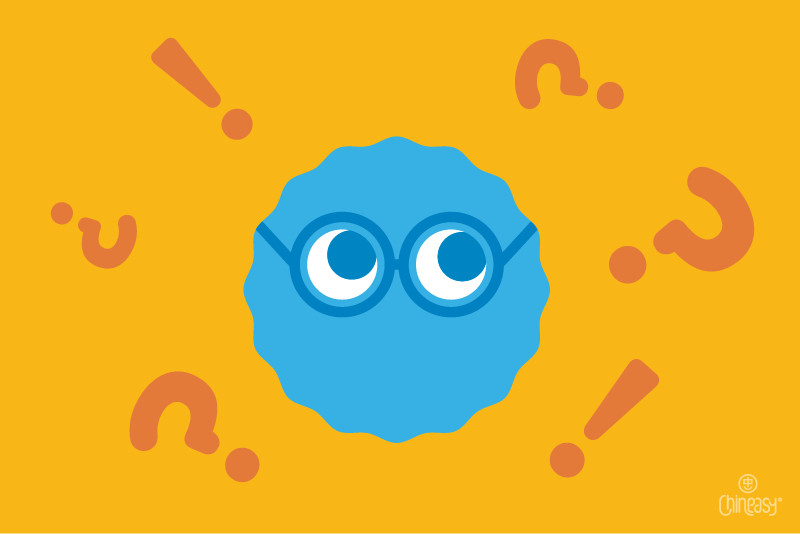Never has a drink had so many nicknames, including Liquid Gold, Brew, Cup of Joe, and more.
We’re talking about Coffee!
Coffee isn’t just a drink; it’s a lifestyle. Many classic literary works, novels, and innovative ideas have started with a sip of coffee in a favorite coffee shop.
Today, you’ll learn 10 must-know Chinese words related to coffee. Whether you’re a seasoned Sinophile or just starting your language journey, this post will help you blend your love for coffee with learning Chinese. Let’s get brewing!
Coffee 咖啡
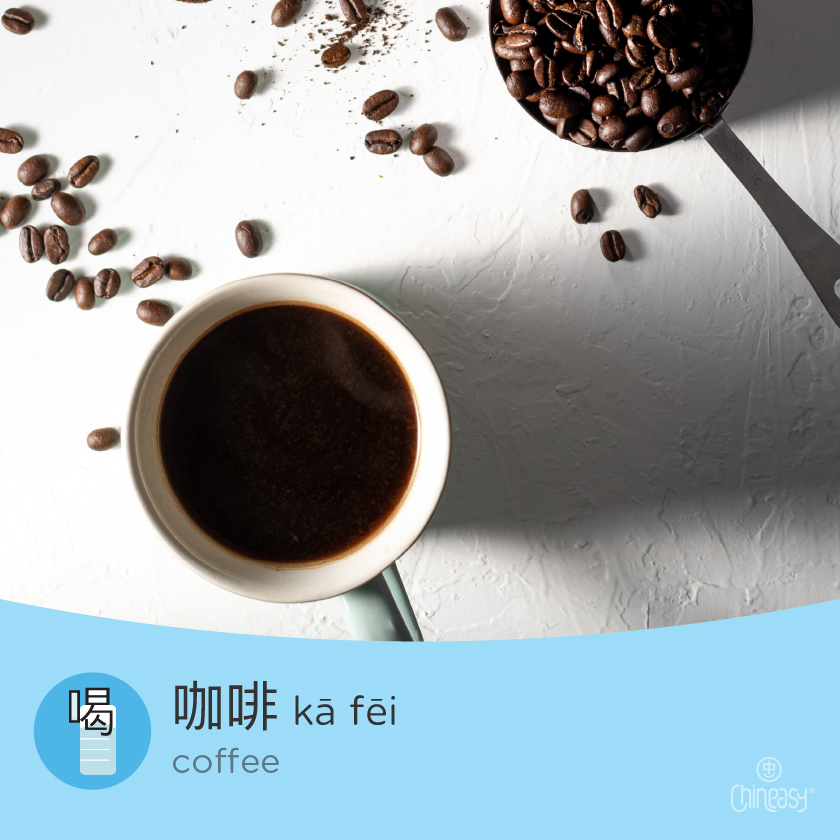
The first coffee of the day feels so good, doesn’t it?
In Chinese, coffee is called 咖啡 (kā fēi). 咖啡 is a loanword, meaning it was borrowed from another language and adapted into Chinese.
In other words, the characters 咖 and 啡 don’t have meanings related to coffee individually, but together, they create the magic word, coffee, we all love.
Not only does coffee wake us up, but it also brings various health benefits.
Did you know coffee is a source of fiber? That’s right, your morning brew is not just energizing but also contributing to your daily nutrient intake.
Coffee Bean 咖啡豆
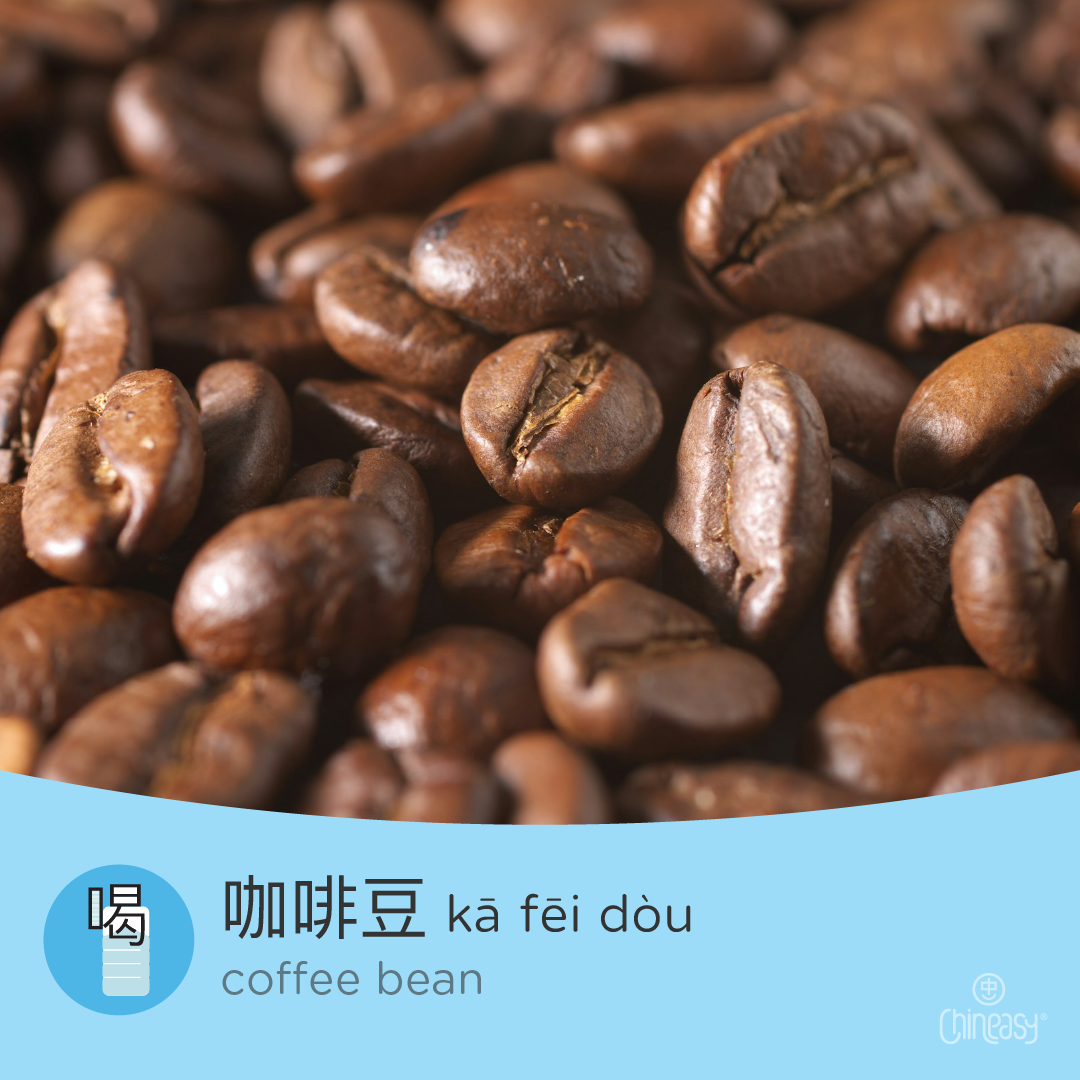
A classic debate among coffee enthusiasts is whether whole coffee beans or ground coffee tastes better. Each has its followers, but one thing is for sure: coffee doesn’t grow on a tree in bean form.
Instead, the coffee beans we brew are the seeds or pits of a small berry referred to as the coffee cherry. The process from cherry to bean involves harvesting, processing, drying, and roasting, with each step crucial in developing the flavors we love.
Coffee cherries thrive in specific environments. These plants need a warm climate, ample rainfall, and rich, well-drained soil. Typically, coffee is grown in regions known as the Coffee Belt, which includes countries in Central and South America, Africa, and Asia.
To say “coffee bean” in Chinese, it’s 咖啡豆 (kā fēi dòu). 咖啡, as you just learned, is “coffee” and 豆 means “bean.”
There are four types of 咖啡豆, each offering unique flavors and characteristics:
- Arabica (阿拉比卡 ā lā bǐ kǎ)
Arabica beans are the most popular type, known for their rich, smooth flavors and less bitterness. They are often grown at higher altitudes and are more susceptible to pests and diseases, which makes them more expensive.
- Robusta (羅布斯塔/罗布斯塔 luó bù sī tǎ)
Followed by Arabica, Robusta is the second most popular type of coffee bean. Robusta beans are easier to grow and are often found at lower altitudes. They are larger compared to other types of coffee beans. They have a stronger, more bitter flavor and higher caffeine content, making them a favorite for espresso blends and instant coffee.
- Liberica (利比里亞/利比里亚 lì bǐ lǐ yà)
The Liberica coffee bean gets its name from Liberia, Africa. Today, they are primarily grown in Indonesia, Malaysia, and the Philippines. The plant tolerates hot, muggy weather better than other types of beans and can grow well at lower altitudes, too. This type of bean is less common, accounting for only around 2% of world coffee production. The beans are highly aromatic and have a unique, smoky flavor. Because of its unique taste, you could either love it or hate it.
- Excelsa (艾塞爾薩/艾塞尔萨 ài sāi ěr sà)
Some would say Excelsa should be classified as a Liberica type of coffee bean, but others would disagree. The beans are exclusively grown in Southeast Asia and are known for their tart, fruity notes. They add complexity and depth to many coffee blends.
Understanding these different types of coffee beans can enhance your appreciation for the diverse flavors and experiences coffee has to offer.
Ground Coffee 咖啡粉
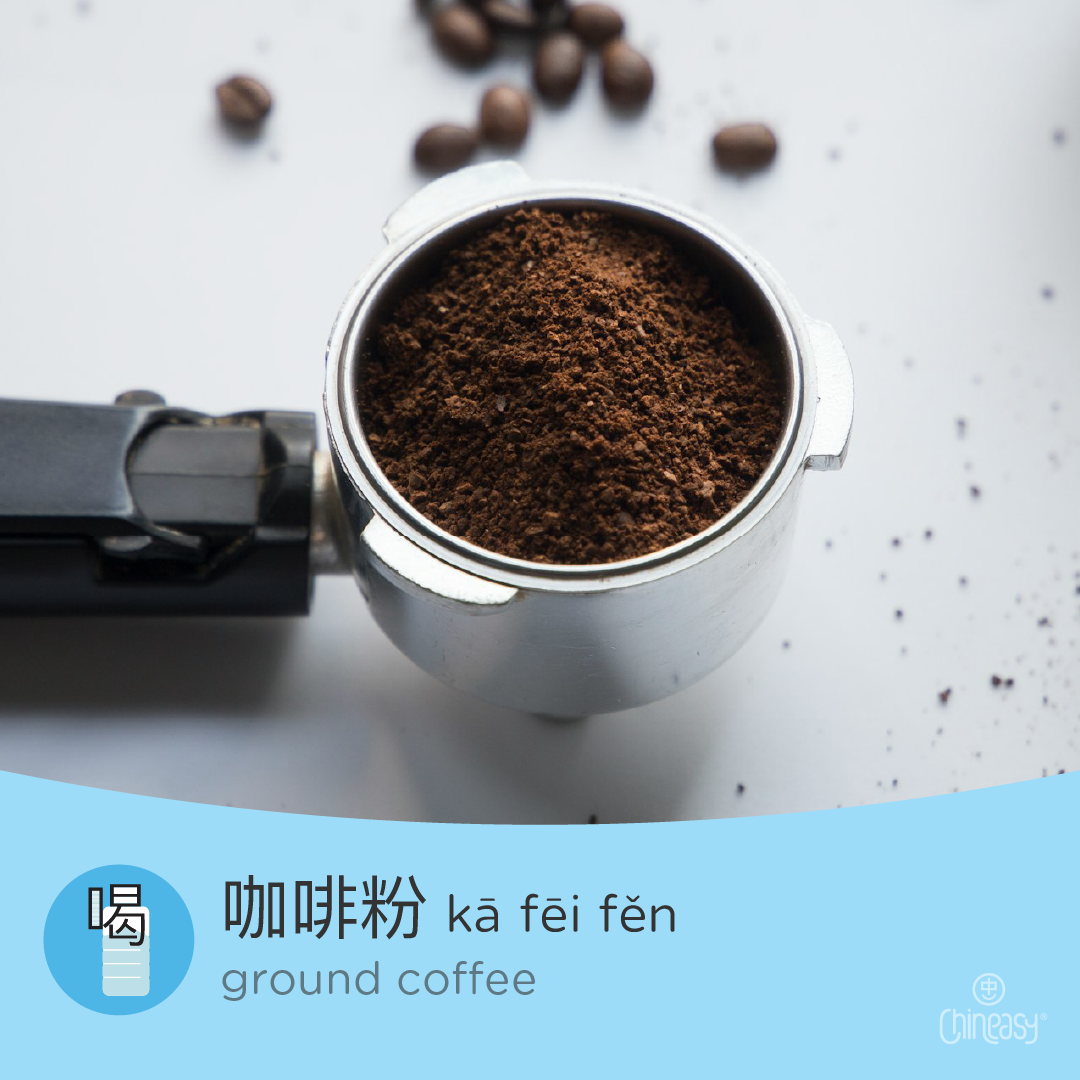
“Ground coffee” in Chinese is 咖啡粉 (kā fēi fěn). The only new word here to learn is 粉 (fěn), meaning “powder.” So the literal translation of 咖啡粉 is “coffee powder.”
When making the perfect cup of coffee, your coffee grind size is crucial. The coarseness or fineness of your ground coffee directly affects the flavor and extraction process, and it should be matched to the type of coffee maker you use.
For example:
- Coarse grind is best for the French press.
- Medium grind is more suitable for drip coffee makers.
- Fine grind is ideal for espresso machines or moka pots.
Choosing the right grind size for your coffee maker ensures you get the best flavor and extraction from your coffee beans.
Espresso 濃縮咖啡/浓缩咖啡
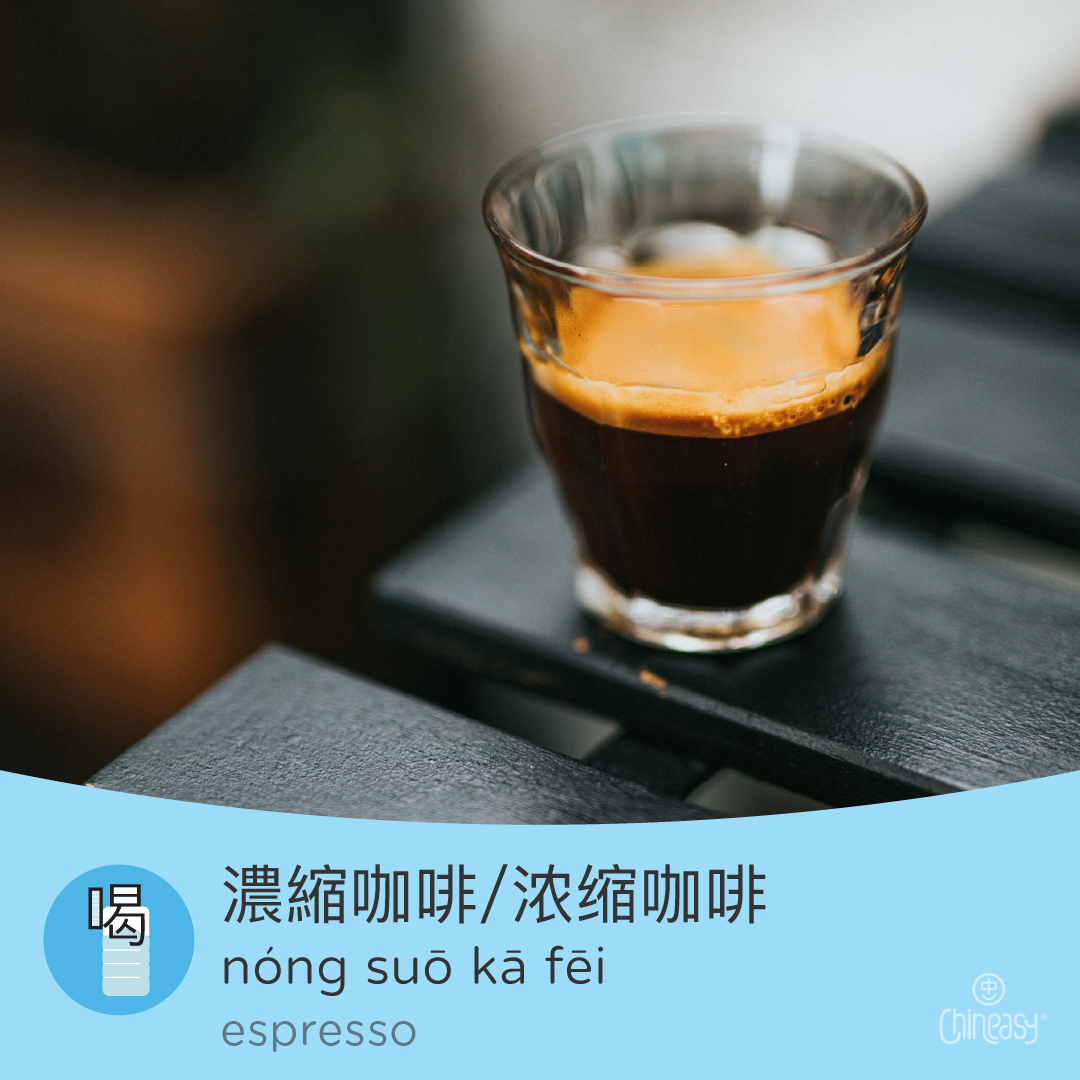
For strong coffee lovers, we have espresso, known as 濃縮咖啡/浓缩咖啡 (nóng suō kā fēi) in Chinese.
濃縮/浓缩 means “concentrated,” so 濃縮咖啡/浓缩咖啡 literally translates to “concentrated coffee.”
This robust and intense coffee is the base for many other drinks, including Americanos, lattes, and cappuccinos. In other words, a good coffee starts with a good espresso as its foundation.
Espresso is also the lowest-calorie type of coffee you can drink. A shot of espresso, approximately 30ml, normally contains around 5 calories.
Americano 美式咖啡
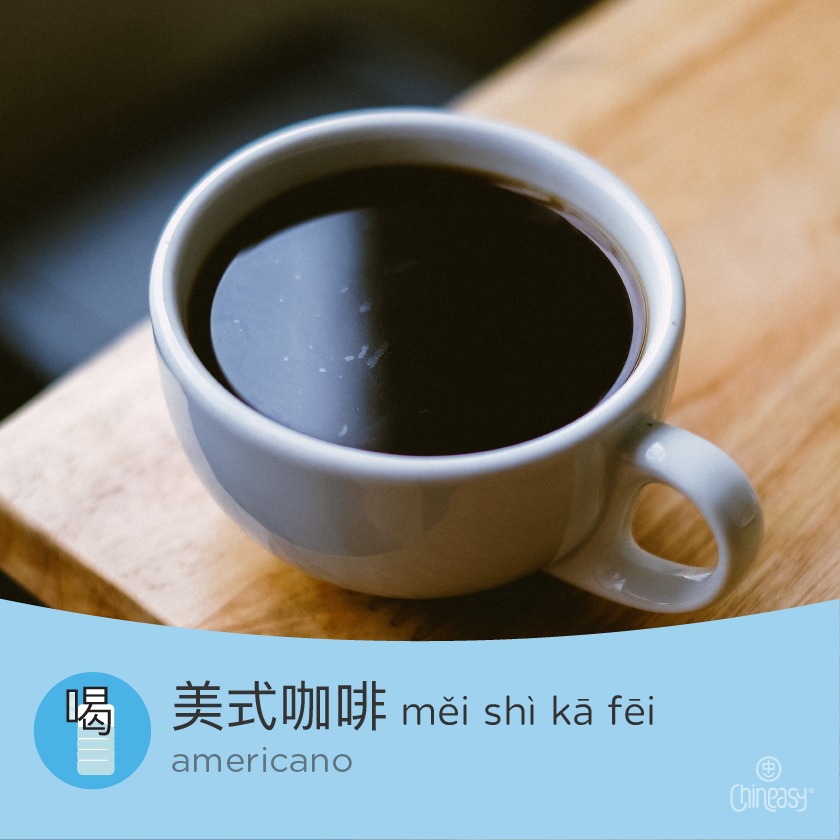
The origin of the Americano dates back to World War II when Italian baristas would approximate the taste of drip coffee for American soldiers by diluting espresso with hot water.
The Americano is called 美式咖啡 (měi shì kā fēi) in Chinese. 美式 means “American style,” so 美式咖啡 translates to “American style coffee.”
This drink creates a smooth and yet still rich coffee experience. If you prefer a milder coffee, the Americano is a great choice.
Latte 拿鐵/拿铁
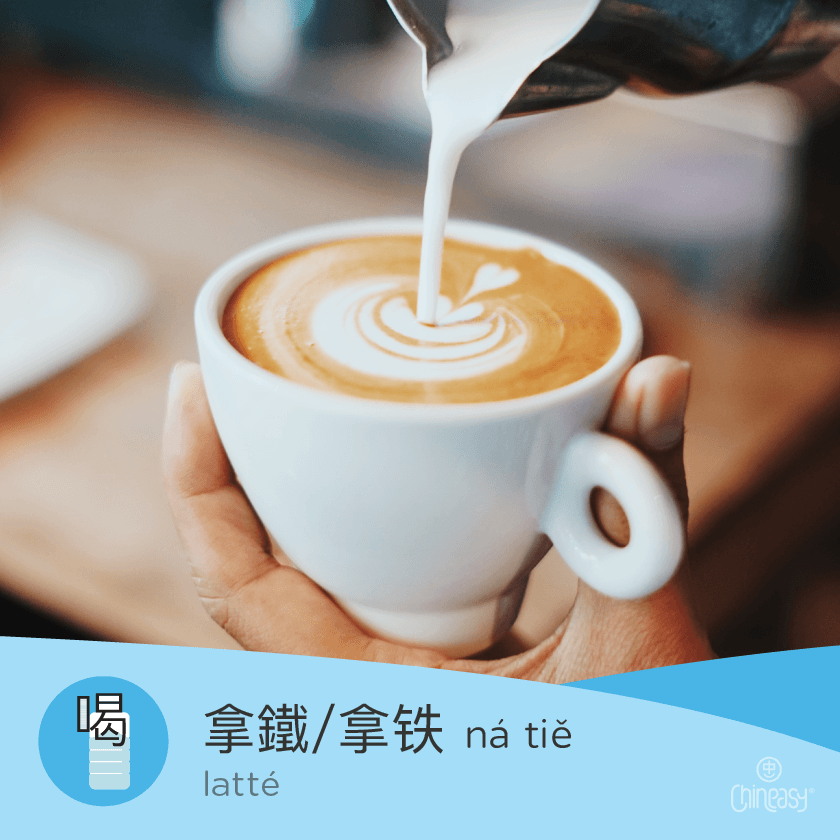
The latte, a beloved coffee drink known for its creamy texture, is called 拿鐵/拿铁 (ná tiě) in Chinese. Like 咖啡 (kā fēi), 拿鐵/拿铁 is a loanword.
A latte is made with espresso and steamed milk, topped with a small amount of milk foam. This combination makes lattes a popular choice for those who enjoy the strong flavor of espresso balanced with the creaminess of the milk.
A trade secret among baristas: using a 220 ml cup (or glass) for a single shot of espresso, steamed milk and milk froth (around 10 ml) can enhance the enjoyment of a latte.
Cappuccino 卡布奇諾/卡布奇诺
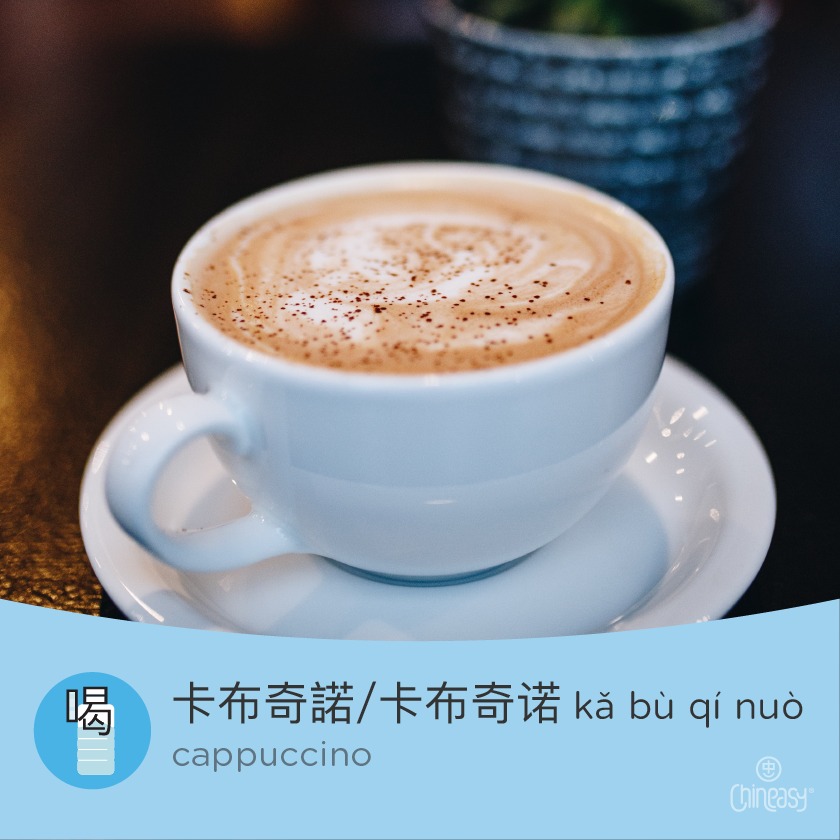
Cappuccino, another favorite among coffee enthusiasts, is called 卡布奇諾/卡布奇诺 (kǎ bù qí nuò) in Chinese. Like many other coffee-related terms, 卡布奇諾/卡布奇诺 is a loanword.
A cappuccino is typically served in a 190 ml cup and consists of equal parts espresso, steamed milk, and milk froth, with approximately 15 ml of froth on top. This combination creates a rich and frothy texture that coffee lovers enjoy.
To enhance the flavor, cappuccinos are often topped with a sprinkle of cocoa powder, cinnamon, or even chocolate shavings.
While both 拿鐵/拿铁 (latte) and 卡布奇諾/卡布奇诺 (cappuccino) are made with espresso and steamed milk, the difference lies in the milk-to-froth ratio and texture.
A latte has more steamed milk and a thin layer of milk foam, resulting in a creamier and smoother drink. In contrast, a cappuccino has less steamed milk and a thicker layer of froth, giving it a stronger coffee flavor and a lighter, airier texture.
Mocha 摩卡
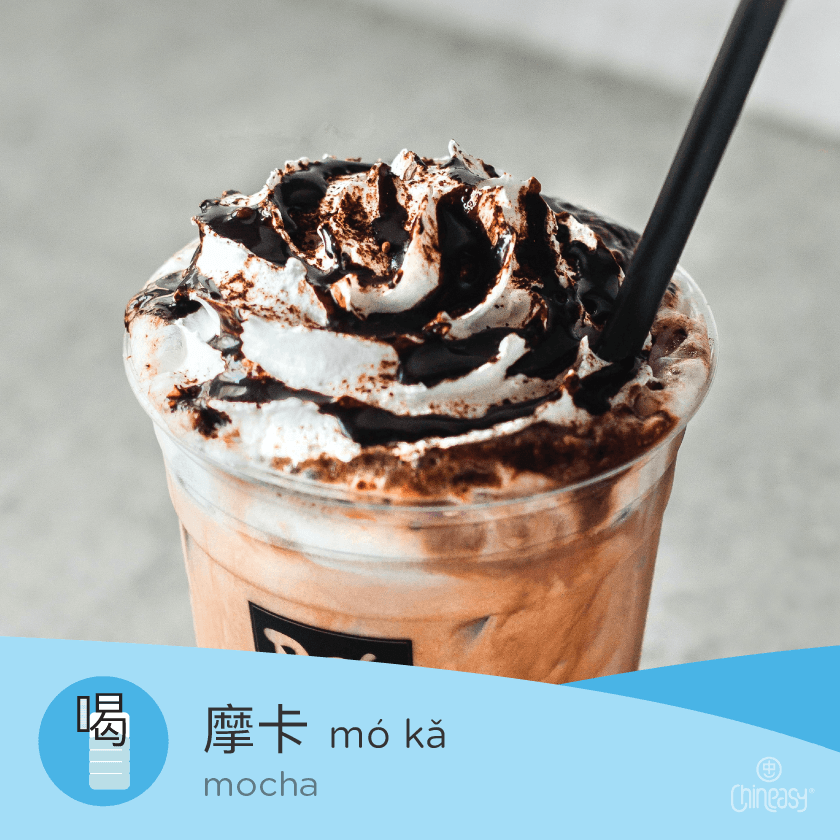
Mocha, the delightful blend of coffee and chocolate, is called 摩卡 (mó kǎ) in Chinese. 摩卡 is a loanword, too.
The name “mocha” comes from the city of Al Moka in Yemen, which was one of the earliest coffee trading centers. Mocha coffee beans from this region were known for their naturally chocolatey flavor, which inspired the combination of coffee and chocolate in this popular drink.
A mocha is made with espresso, steamed milk, and chocolate syrup or cocoa powder, topped with whipped cream or chocolate shavings for added indulgence. The result is a rich, sweet, and comforting coffee experience that appeals to both coffee and chocolate lovers.
Flat White 平白咖啡
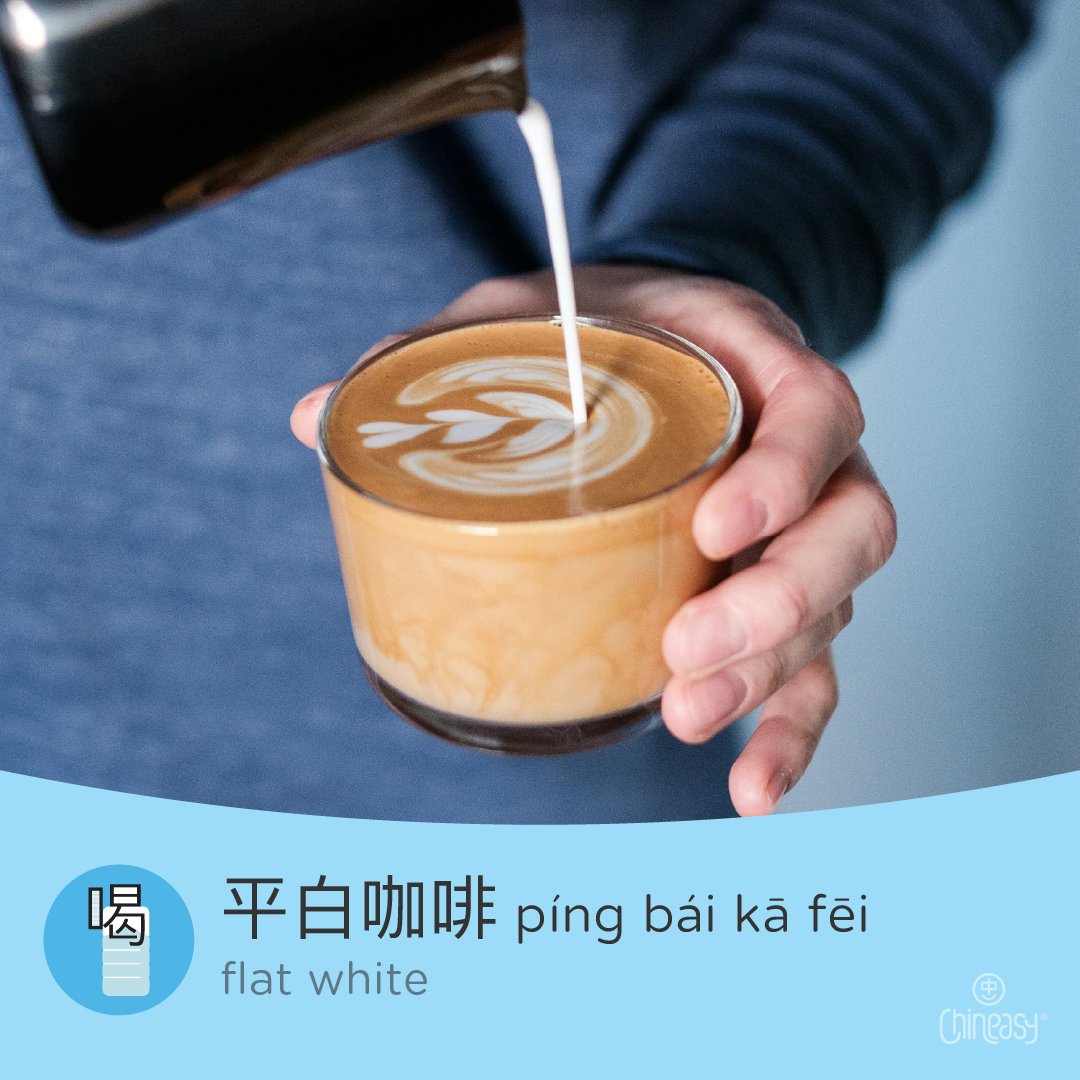
Among all the coffee types, the origin of the flat white can be quite disputable. Some claim it was first crafted in Australia, while others believe it originated in England.
Despite the debate, the flat white has become a beloved coffee choice worldwide.
In Chinese, flat white is called 平白咖啡 (píng bái kā fēi). 平 translates to “flat.” 白 means “white,” referring to the milk.
A flat white is similar to a 拿鐵/拿铁 (latte) but with a few key differences. It is made with a shot or two of espresso and microfoam, which is steamed milk with very fine bubbles that create a velvety texture.
Unlike a latte, a flat white has a higher coffee-to-milk ratio, giving it a stronger coffee flavor while maintaining a creamy mouthfeel.
This balance of bold espresso and silky milk makes the flat white a favorite for those who appreciate a strong yet smooth coffee experience.
Iced Coffee 冰咖啡
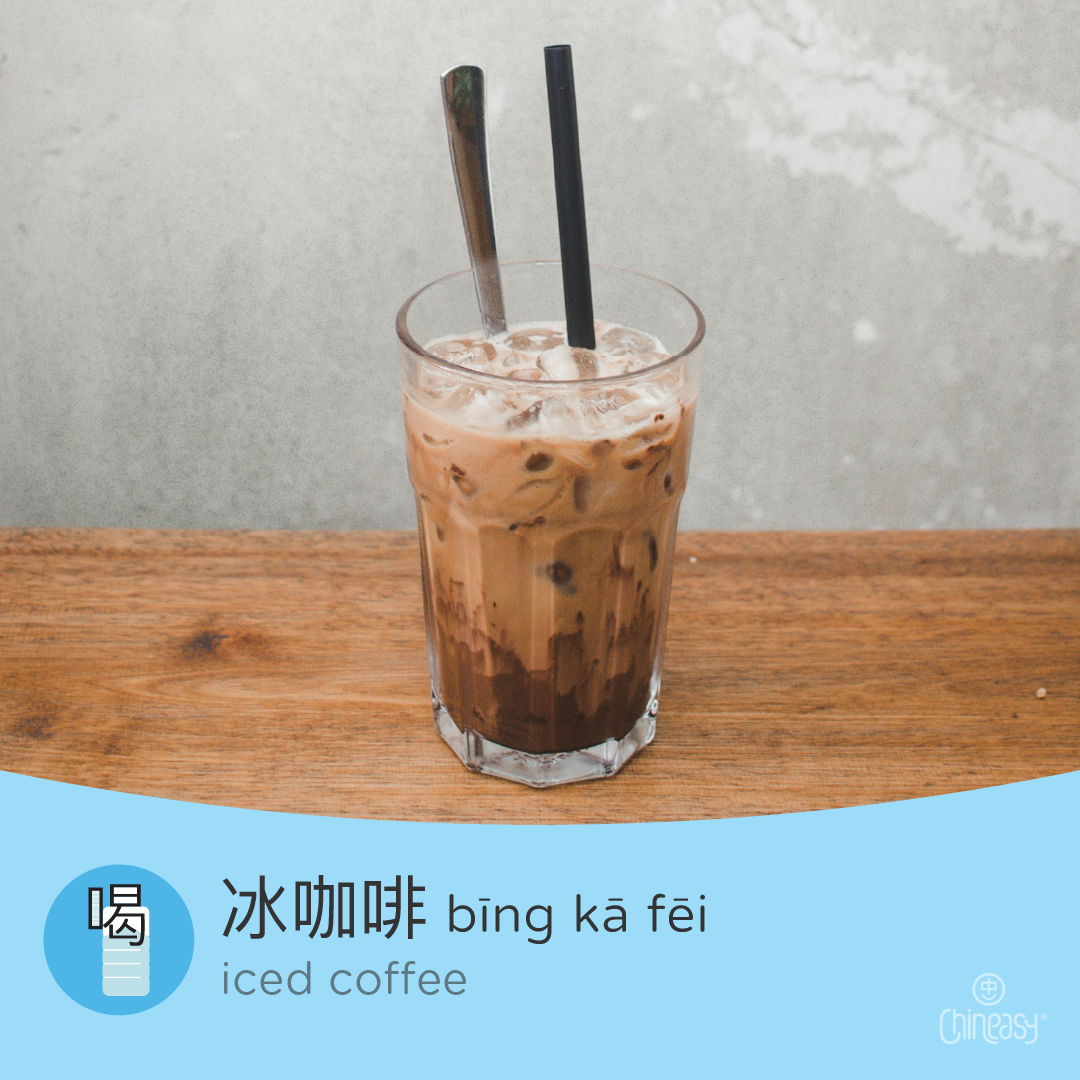
Coffee isn’t just a warm comfort; it can also be enjoyed cold, especially on hot days.
In Chinese, iced coffee is called 冰咖啡 (bīng kā fēi). 冰 means “ice” or “cold.”
Iced coffee can be made in various ways, but it typically involves brewing hot coffee and then chilling it, either by letting it cool naturally or by pouring it over ice. Some popular variations include adding milk, cream, or sweeteners to enhance the flavor.
Cold brew, a method where coffee grounds are steeped in cold water for an extended period (18 – 24 hours), is another way to enjoy iced coffee. It results in a smoother, less acidic beverage.
Whether you prefer it black, with milk, or as a cold brew, iced coffee is a refreshing and versatile way to enjoy your favorite drink in a chilled form.
Now, here you have it—10 Chinese words related to coffee. You don’t need to learn them all in one go. Start with the loanwords and gradually move on to the more challenging terms. Practice these words regularly to reinforce your learning. Next time you order a coffee, try using these Chinese term and impress your barista!
Credit: Photos courtesy of Unsplash.

